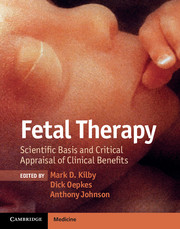Book contents
- Frontmatter
- Contents
- Contributors
- Foreword
- Preface
- Section 1 General principles
- Section 2 Fetal disease
- Chapter 6 Red cell alloimmunization
- Chapter 7 Fetal and neonatal alloimmune thrombocytopenia
- Chapter 8.1 Fetal dysrhythmias
- Chapter 8.2 Fetal dysrhythmias
- Chapter 9.1 Structural heart disease
- Chapter 9.2 Structural heart disease
- Chapter 9.3 Structural heart disease
- Chapter 10.1 Manipulation of amniotic fluid volume
- Chapter 10.2 Manipulation of amniotic fluid volume
- Chapter 11.1 Twin-to-twin transfusion syndrome
- Chapter 11.2 Twin-to-twin transfusion syndrome
- Chapter 11.3 Twin-to-twin transfusion syndrome
- Chapter 11.4 Twin-to-twin transfusion syndrome
- Chapter 11.5 Twin-to-twin transfusion syndrome
- Chapter 12.1 Twin reversed arterial perfusion (TRAP) sequence
- Chapter 12.2 Twin reversed arterial perfusion (TRAP) sequence
- Chapter 13.1 Fetal infections
- Chapter 13.2 Fetal infections
- Chapter 14.1 Fetal urinary tract obstruction
- Chapter 14.2 Fetal urinary tract obstruction
- Chapter 14.3 Fetal urinary tract obstruction
- Chapter 14.4 Fetal urinary tract obstruction
- 15.1 Fetal lung growth, development, and lung fluid
- Chapter 15.2 Fetal lung growth, development, and lung fluid
- Chapter 16.1 Neural tube defects
- Chapter 16.2 Neural tube defects
- Chapter 17.1 Fetal tumors
- Chapter 17.2 Fetal tumors
- Chapter 18.1 Intrauterine growth restriction
- Chapter 18.2 Intrauterine growth restriction
- Chapter 19.1 Congenital diaphragmatic hernia
- Chapter 19.2 Congenital diaphragmatic hernia
- Chapter 20.1 Fetal stem cell transplantation
- Chapter 20.2 Fetal stem cell transplantation
- Chapter 20.3 Fetal stem cell transplantation
- Chapter 21 Gene therapy
- Chapter 22 The future
- Glossary
- Index
- References
Chapter 11.2 - Twin-to-twin transfusion syndrome
placental circulation
from Section 2 - Fetal disease
Published online by Cambridge University Press: 05 February 2013
- Frontmatter
- Contents
- Contributors
- Foreword
- Preface
- Section 1 General principles
- Section 2 Fetal disease
- Chapter 6 Red cell alloimmunization
- Chapter 7 Fetal and neonatal alloimmune thrombocytopenia
- Chapter 8.1 Fetal dysrhythmias
- Chapter 8.2 Fetal dysrhythmias
- Chapter 9.1 Structural heart disease
- Chapter 9.2 Structural heart disease
- Chapter 9.3 Structural heart disease
- Chapter 10.1 Manipulation of amniotic fluid volume
- Chapter 10.2 Manipulation of amniotic fluid volume
- Chapter 11.1 Twin-to-twin transfusion syndrome
- Chapter 11.2 Twin-to-twin transfusion syndrome
- Chapter 11.3 Twin-to-twin transfusion syndrome
- Chapter 11.4 Twin-to-twin transfusion syndrome
- Chapter 11.5 Twin-to-twin transfusion syndrome
- Chapter 12.1 Twin reversed arterial perfusion (TRAP) sequence
- Chapter 12.2 Twin reversed arterial perfusion (TRAP) sequence
- Chapter 13.1 Fetal infections
- Chapter 13.2 Fetal infections
- Chapter 14.1 Fetal urinary tract obstruction
- Chapter 14.2 Fetal urinary tract obstruction
- Chapter 14.3 Fetal urinary tract obstruction
- Chapter 14.4 Fetal urinary tract obstruction
- 15.1 Fetal lung growth, development, and lung fluid
- Chapter 15.2 Fetal lung growth, development, and lung fluid
- Chapter 16.1 Neural tube defects
- Chapter 16.2 Neural tube defects
- Chapter 17.1 Fetal tumors
- Chapter 17.2 Fetal tumors
- Chapter 18.1 Intrauterine growth restriction
- Chapter 18.2 Intrauterine growth restriction
- Chapter 19.1 Congenital diaphragmatic hernia
- Chapter 19.2 Congenital diaphragmatic hernia
- Chapter 20.1 Fetal stem cell transplantation
- Chapter 20.2 Fetal stem cell transplantation
- Chapter 20.3 Fetal stem cell transplantation
- Chapter 21 Gene therapy
- Chapter 22 The future
- Glossary
- Index
- References
Summary
Introduction
Monochorionic (MC) twin and triplet pregnancies pose complex clinical problems and high risks of types that are not seen in dichorionic (DC) twin pregnancies. About 40% of MC twin pregnancies have major complications, and perinatal deaths are frequent. Fetal growth discordance (FGD) and twin-to-twin transfusion syndrome (TTTS) are the most common problems. The MC twin placenta is usually a truly single, not fused, placenta that is produced by a single zygote and intended for the metabolic support of a singleton fetus (but rare departures from this rule are noted in “Exceptions” below). When monozygotic (MZ) twinning occurs within 48 hours of conception, the whole zygote splits and the result is twinning of the embryos and their placentae (MZ, DC placentation). Thereafter, the inner cell mass (ICM) and trophoblast separate. If a twinning event is confined to the ICM after the ICM has physically separated from the trophoblast, the single structure and function of the MC twin placenta is retained as such. The single trophoblast resolutely declines to respond to the confined ICM twinning event, and does not “retrofit” to DC, although this would be much safer for the fetuses, and is close to the objective of laser occlusion in TTTS. There are three vascular consequences of the insertion of two or more umbilical cords into an MC placenta:
Cord insertions: asymmetric cord insertions, e.g., eccentric/velamentous combination, with unequal parenchymal sharing if the cord insertions are markedly asymmetric, result in significant FGD [1, 2]; many TTTS cases have FGD and also have asymmetric cord insertions; twin reversed arterial perfusion (TRAP) is a risk if cord insertions are close together.
Single umbilical artery: special considerations apply if one MC twin has a single umbilical artery. Acardiac TRAP fetuses all have a single umbilical artery.
Interfetal vascular connections: the presence of interfetal vascular connections on the chorionic plate and in the placental parenchyma is a major determinant of MC twin fetal outcomes, especially TTTS.
Keywords
- Type
- Chapter
- Information
- Fetal TherapyScientific Basis and Critical Appraisal of Clinical Benefits, pp. 156 - 165Publisher: Cambridge University PressPrint publication year: 2012



